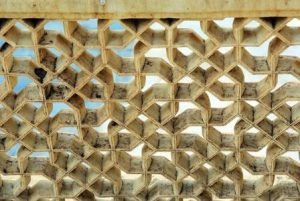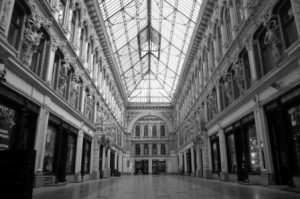In today’s world, we are surrounded by ‘modern’ buildings that we live, work and shop in, with not much awareness about the way these buildings are lit, either by natural or the electrical light. With issues like climate change and the increasing pressure on energy requirements, we need to look at ways and means to not only make buildings energy efficient by using technologies like the LEDs, but also by harnessing natural light in today’s buildings.

Buildingandinteriors.com discusses a range of issues concerning lighting in buildings with Professor Warren Julian, Emeritus Professor at the Faculty of Architecture, Design and Planning, University of Sydney, Australia. Professor Julian has spent over 30 years in working on lighting education. He is considered an authority by many, in the field of lighting and on the ways lighting can be used all around us.
B&I: Lighting plays a very important role in our lives. How do you see lighting as a component of the overall architecture in buildings of today?
WJ: We all need light to carry out our daily tasks. What we, as architects, lighting designers, developers, builders and lighting suppliers, need to realise is that while electrical lighting in the buildings is important, what is equally important is not to be ‘oblivious’ to the fact that in warm countries like India, sunlight ‘can’ and ‘should’ play an important role in getting ‘light’ into the buildings. In Australia, which has a climate similar to India, say around 200 lux of light is required in classrooms. This is way less than the 100,000 lux available outside at noon. Now, if windows can be designed in ways that get the light reflected-off the ground (10-20% of the total light from the sun is reflected) to wash the ceiling (which is typically white, or off-white), and with ceilings having a reflectance of 0.8, it becomes very easy to harness the sunlight without getting the heat into the classrooms.
In India, it is in such situations that associations like ISLE (Indian society for Lighting Engineers) and ELCOMA (Electric Lamp and Components Manufacturers’ Association of India), can work in tandem with the architects, developers and the government to spread awareness on harnessing natural light in buildings.
B&I: Are there some cues we can take, on the use of natural light, from the way the buildings were designed in the past?

WJ: There are many examples across the world which point to the fact that daylight was an important aspect considered while designing buildings. If one looks at buildings at the time of industrial revolution, especially the factories, these had large openings to get the natural light in. In India, natural light and air were harnessed quite efficiently. Jaipur Fort used screens that provided thermal (stopping heat from coming in) and visual (using the reflected daylight) characteristics.
B&I: What are the challenges you see in the use of daylight in the present day buildings?
WJ: Most of the buildings being designed across the world are being done with the concepts borrowed from the West viz., Europe and the United States. As a result, buildings around the world have starting looking the same. Buildings have glass-box designs, shopping centres look like caves (with those inside having no idea of the conditions outside – obviously to control the purchase behaviour of the shoppers) and factories that resemble metal boxes. With big glass facades, and with the ‘orientation’ of buildings having no regard for the light available outside, probably only a few buildings in the same block use daylight well. All the other buildings only ‘conform’ to the visual appeal of the block. Then there are challenges on the interface between the architect, lighting designer, builder and suppliers. Mostly, the suppliers and the architects have to ‘give in’ to the market forces (represented by the builder and the suppliers). The end result is the buildings that increasingly depend upon electrical lighting, with an increased pressure on electricity consumption through airconditioning, etc. Though here, I must add that the LEDs have helped in a big way by not only reducing the consumption of electricity by the lights in building but also by keeping the heat generated by the light source at an optimum level. But there’s no denying the fact that still there’s no substitute for the savings that we can do with the usage of daylight in modern buildings.
B&I: What role do you see for lighting designers in buildings?
WJ: In my view, the real revolution in buildings can come when the window designing is handed over to the lighting designers. Lighting designers are the best judge when it comes to getting ‘natural’ light into the buildings. And windows being the interface to get the light into the buildings, well-designed windows can solve many problems in this situation. But the practical side of the story is that the architect needs to have a ‘control’ over the window designs since he is looking at the aesthetics of the building, and for him, the window design is important. Then, you have the mechanical teams who need to take responsibility of the windows to look at lighting and cabling requirements. The best solution in the given situation would be a concerted effort from all the three. But then (!) there’s the builder who is looking at maximising the number of sq.m. on a plot of land. The net result is that the market forces dictate the form factor and we don’t seem to make much headway.
On the other hand, there are holiday resorts which use ‘natural light’ to such a nice extent. But they charge you exorbitantly (laughs) that many don’t get to afford it to be able to appreciate the concept of the use of daylight in buildings.
B&I: In India, we see an increased use of LEDs in street lighting. Still, we have dark areas, poorly lit streets, etc. How do you see the whole situation?
WJ: Well, in a country like India, you have a combination of hot, cold, dry and wet conditions over a year. And there are many countries with similar climate. During the day, the enclosure of the street light heats up. The hot air inside the enclosure expands and pushes itself out. This creates a partial vacuum which results in water vapours and dust entering the enclosure. This results in the improper functioning of the street lights. Then there are maintenance issues where the person responsible for cleaning the street lights doesn’t put the seal and the cover back on the street light once it has been cleaned.
So, a well designed street light is important. Given that most of the product categories all around us are fiercely competitive, the qualityof products is getting diluted gradually. Lighting, unfortunately, is also a victim in these market dynamics.
B&I: What role do you see for countries like India and China playing in designing lighting solutions?
WJ: India and China account for a good 2/3rd of the total world population. For both these countries to adopt lighting standards from Europe is not practical. European countries, with much colder climates, put a different stress on the electronics (present in the lighting solutions). India and China, with much more warmer climates put the electronics to a very different test. In most of my working with the lighting industry (over 30 years), I have been a proponent of India and China play greater roles in the technical standardisations in lighting to suit their respective geographies.
Professor Warren Julian can be reached on [email protected]



























